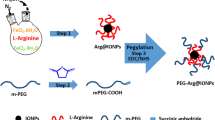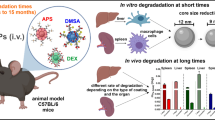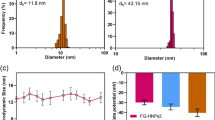Abstract
Degradation is the long-existing toxic issue of metal-containing inorganic medicine. In this paper, we fully investigated the degradation of dextran-coated KMnF3 nanocube in the in vitro and in vivo surroundings. Different from the general decomposing and ion releasing events, this special agent is resistant to acidic environment, as well as ion exchange. Non-degradability was proved by simulated and real cellular experiments. Moreover, it can be engulfed in the macrophage cells and kept stable in the lysosome. Due to its stability and highly selective phagocytosis, implanted liver cancer can be clearly visualized after administration.







Similar content being viewed by others
References
Bennewitz MF, Lobo TL, Nkansah MK, Ulas G, Brudvig GW, Shapiro EM (2011) Biocompatible and pH-sensitive PLGA encapsulated MnO nanocrystals for molecular and cellular MRI. ACS Nano 5:3438–3446
Canton I, Battaglia G (2012) Endocytosis at the nanoscale. Chem Soc Rev 41:2718–2739
Crossgrove J, Zheng W (2004) Manganese toxicity upon overexposure. NMR Biomed 17:544–553
Kim T, Cho EJ, Chae Y, Kim M, Oh A, Jin J, Lee ES, Baik H, Haam S, Suh JS, Huh YM, Lee K (2011) Urchin-shaped manganese oxide nanoparticles as pH-responsive activatable T1 contrast agents for magnetic resonance imaging. Angew Chem Int Ed 50:10589–10593
Li YF, Chen CY (2011) Fate and toxicity of metallic and metal-containing nanoparticles for biomedical applications. Small 7:2965–2980
Liu C, Gao Z, Zeng J, Hou Y, Fang F, Qiao R, Shen L, Lei H, Yang W, Gao M (2013a) Magnetic/upconversion fluorescent NaGdF4:Yb, Er nanoparticle-based dual-modal molecular probes for imaging tiny tumors in vivo. ACS Nano 7:7227–7240
Liu Z, Song X, Tang Q (2013b) Development of PEGylated KMnF3 nanoparticle as a T1-weighted contrast agent: chemical Synthesis, in-vivo brain MR images, and account for high relaxivity. Nanoscale 5:5073–5079
Liu Z, Song X, Xu X, Tang Q (2014) Biocompatible KMnF3 nanoparticular contrast agent with proper plasma retention time for in-vivo magnetic resonance imaging. Nanotechnology 25:155101–155108
Lu ZR, Parker DL, Goodrich KC, Wang XH, Dalle JG, Buswell HR (2004) Extracellular biodegradable macromolecular gadolinium(III) complexes for MRI. Magn Reson Med 51:27–34
Na HB, Song IC, Hyeon T (2009) Inorganic nanoparticles for MRI contrast agents. Adv Mater 21:2133–2148
Nel AE, Madler L, Velegol D (2009) Understanding biophysicochemical interactions at the nano-bio interface. Nat Mater 8:543–557
Perazella MA (2008) Gadolinium-contrast toxicity in patients with kidney disease: nephrotoxicity and nephrogenic systemic fibrosis. Curr Drug Saf 3:67–75
Sahay G, Alakhova DY, Kabanov AV (2010) Endocytosis of nanomedicines. J Control Release 145:182–195
Schmidt PP, Toft KG, Skotland T, Andersson KK (2002) Stability and transmetallation of the magnetic resonance contrast agent MnDPDP measured by EPR. J Biol Inorg Chem 7:241–248
Shapiro EM, Koretsky AP (2008) Convertible manganese contrast for molecular and cellular MRI. Magn Reson Med 60:265–269
Song X, Xu X, Wan H, Tang Q (2014) Development of biocompatible nanocubes as a T1-contrast enhancer for MR imaging of primary and metastatic liver cancer. RSC Adv 4:55003–55009
Toft KG, Hustvedt SO, Grant D, Martinsen I, Gordon PB, Frusk GA, Korsmo AJ, Skotland T (1997) Metabolism and pharmacokinetics of MnDPDP in man. Acta Radiol 38:677–689
Valko M, Rhodes CJ, Moncol J, Izakovic M, Mazur M (2009) Free radicals, metals and antioxidants in oxidative stress-induced cancer. Chem Biol Interact 160:1–40
Ye Z, Jeong E, Wu X, Tan M, Yin S, Lu ZR (2012) Polydisulfide manganese(II) complexes as non-gadolinium biodegradable macromolecular MRI contrast agents. J Magn Reson Imaging 35:737–744
Acknowledgments
This work is financially supported by the National Natural Science Foundation of China (21361018), the Natural Science Foundation of Jiangxi Province (20151BAB203004), and The China Scholarship Council. The authors acknowledge Jian-qi Li (Shanghai Key Lab of Magnetic Resonance) for helpful discussion and in vivo MRI operation.
Author information
Authors and Affiliations
Corresponding author
Electronic supplementary material
Below is the link to the electronic supplementary material.
Rights and permissions
About this article
Cite this article
Chen, FY., Gu, ZJ., Zhao, D. et al. Non-degradable contrast agent with selective phagocytosis for cellular and hepatic magnetic resonance imaging. J Nanopart Res 17, 357 (2015). https://doi.org/10.1007/s11051-015-3161-8
Received:
Accepted:
Published:
DOI: https://doi.org/10.1007/s11051-015-3161-8




